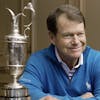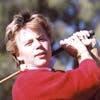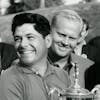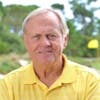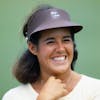Jane Blalock - Part 2 (The Early Wins)

In this captivating second episode of our four-part interview series with Jane Blalock, you're in for a special treat as we dive deep into the legendary golfer's incredible career and experiences on and off the course. Co-hosts Mike Gonzalez and Bruce Devlin lead the conversation, discussing everything from Jane's earliest days on the LPGA Tour to the electrifying tournaments that made her a household name.
Jane shares the stage with some of the greatest names in women's golf—Louise Suggs, Patty Berg, Marilyn Smith, and Kathy Whitworth, to name just a few—and reveals how she found her own unique place among these stars. She takes us through the unforgettable moments, like her wins at the Suzuki Golf International and how beating Kathy Whitworth was nothing short of "very, very special."
The episode goes beyond the scorecards and trophies, providing listeners with a look into the camaraderie and struggles of women in golf. Jane reminisces about the early days of the LPGA Tour, describing it like a "traveling circus" where players would caravan from one city to the next, united in their love for the game and each other. And for a dash of nostalgia, she even recalls the era's CB radios, though she can't quite remember her handle.
But what truly sets this episode apart is how it captures the human element of the sport. Jane shares delightful anecdotes, such as John Cook and Mark O'Meara being her "lucky charms" during key wins, adding a layer of personality and sentimentality that is often overlooked.
Don't miss this chance to hear from one of the golfing greats in her own words and if you love what you're hearing, please spread the word, "FORE the Good of the game."
Follow our show and/or leave a review/rating on:
Our Website https://www.forethegoodofthegame.com/reviews/new/
Apple Podcasts https://podcasts.apple.com/us/podcast/fore-the-good-of-the-game/id1562581853
Spotify Podcasts https://open.spotify.com/show/0XSuVGjwQg6bm78COkIhZO?si=b4c9d47ea8b24b2d
Google Podcasts https://podcasts.google.com/feed/aHR0cHM6Ly9mZWVkcy5idXp6c3Byb3V0LmNvbS8xNzM3Mjc1LnJzcw
About
"FORE the Good of the Game” is a golf podcast featuring interviews with World Golf Hall of Fame members, winners of major championships and other people of influence in and around the game of golf. Highlighting the positive aspects of the game, we aim to create and provide an engaging and timeless repository of content that listeners can enjoy now and forever. Co-hosted by PGA Tour star Bruce Devlin, our podcast focuses on telling their life stories, in their voices. Join Bruce and Mike Gonzalez “FORE the Good of the Game.”
Thanks so much for listening!
Music playing 00:00
Mike Gonzalez 00:15
So let's just talk about the professional career and recap it briefly for Jane Blalock turning professional in 1969 at a fairly young age 23. 34 Professional wins as Bruce had mentioned, including 27 on the LPGA Tour. That's tied for 19th all-time. I will also mention that everybody else that's got 21 or more wins on that list is in the World Golf Hall of Fame, we're going to talk about that, including a couple of ladies that have less than 27 wins and no majors. But Jane also won four times on the Japanese Tour. As she just mentioned, Rookie of the Year and 69. We'll talk about that opening year because it's always interesting to talk about that first year out on the road. But also most improved golfer in 1970-71 comeback player the year in 1985. Bruce, this next stat is probably the most astounding one we've come across.
Devlin, Bruce 01:20
It's actually it's actually quite unbelievable, really, when you think about it, is that this young lady made the cut in 299 consecutive golf tournaments. Now there was a lot of talk a few years ago about Tiger being so talented that he made nearly 150 cuts in a row. And that was that was spread all over the world. But he was so great. Well, Jane Blalock may 299 in a row. That's, you know, something, Jane, it is hard to believe because it is an unbelievable number.
Blalock, Jane 02:01
Sounds like I couldn't quite get to that 300 right?
Mike Gonzalez 02:06
To that end, I mean, were you aware of the number at the time? And if so, did you feel a little bit of pressure on that 300
Blalock, Jane 02:14
I was. They had started talking about it, not to the extent of Tiger because again, it wasn't the big media hype at that time. But the interesting story is that I was not planning to play that tournament in Northern California, I didn't. I played that course before. And it didn't appeal to me. And I played several weeks in a row. So I was resting. I was home in New Hampshire with a week off when the phone rang. And it was the Commissioner back then, and he said, we need you because the LPGA contracts, they had to guarantee five of the top 10. And I said, I know I'm so tired. I'm on the other coast. And I really didn't want to do it. And was my parents who said you have a responsibility. The LPGA has given you this opportunity, therefore you have to go so I went reluctantly. And it was actually hit it I think OB on the last hole to miss by one.
Devlin, Bruce 03:25
Oh Boy.
Blalock, Jane 03:27
And, you know, I knew and I do remember specifically I had about a 20 foot putt that were I would have made it and and it lipped out. So it was I guess it was fate. I really didn't want to go I didn't love the layout that Golf Course it didn't suit me. And there we go. So 299 It's you know, 300 is kind of a boring number. Even. Yeah, we a few of us that didn't get to play the weekend, went to Carmel and had a great time celebrating the fact that the streak was now over.
Mike Gonzalez 04:06
Yeah. Quite amazing. Well anyway, let's go back to 1969 first year on tour just take us through what that was like going out on the road not knowing courses, not knowing what hotels to stay in and places to eat and
Blalock, Jane 04:20
oh, it was scary is an understatement. It's like talk about a total change in lifestyle from the sheltered world of New Hampshire and an Ocean Reef. And so I told you I had met Jan Ferraris at Ocean Reef. And so she asked if I wanted to room with her. So I said Yeah, because she had been. She had been out on the tour for I think a couple of years. I think she had joined much, much younger than than I had. So she kind of showed me some of the ropes and so I remember my first tournament in in Louisville. Louisville, I gotta say that properly, and, you know, I was paired with, with Betsy Rawls and Betsy Cullen and watching Mickey Wright on the driving range. And I remember watching Mickey practice, and I walked so far behind her, so I wouldn't disturb her. You know, just I say, Wow, I'm here with with all these all these great players. And I held my own. And I finish, you know, it was like, top least top 20. And it just really scary but again, just felt so lucky. Remember, it was just for a year, I'm only going to try this. So. And then, you know, I continue to do okay, now. Didn't make any headlines. And just, you know, thoroughly enjoy it. I was traveling the country I was seeing I was seeing the country in a way that I never would have if you just travel and stayed in a lot of private housing and just met wonderful people. So I was on top of the world. I just felt so fortunate to be playing a game, you know, that I loved for a year.
Mike Gonzalez 06:09
So what did you do with that big $264 check you cashed in Louisville?
Blalock, Jane 06:17
I used it to play the next week. I did not spend it very very frugal, for sure. And yeah, so it was that rookie year, I started. Let's see, I was started mid year. So it wasn't just if I you know, they used to play a lot in January, February. I think it was in May or you May or June of that year.
Mike Gonzalez 06:40
Well, you know, you go back to this 1969 and LPGA had only started in 1950. So it was still a young fledgling tour. You were rubbing elbows with some of the founders because at that time, some of them were still playing some of them maybe not the top of their game anymore. I got to ask you this. You got $100 to bet you got to put it on one player. For a 72 hole event. I'm going to give you four choice, you pick your horse, Patty Berg, Louise Suggs. Mickey Wright or Kathy Whitworth, who do you bet on?
Blalock, Jane 07:17
I have to bet on Kathy Whitworth. Everyone else would say Mickey, but Kathy
Devlin, Bruce 07:22
Yeah, they would, everyone would say Mickey I think
Blalock, Jane 07:24
Ultimate competitor. Mickey the finest ball striker, greatest female player ever. Of course, I never got to see Babe Zaharias play so but yeah, Mickey was just incredible. But you could never ever bet bet against Kathy.
Devlin, Bruce 07:42
When you look at Kathy, you know, we know Kathy's record, most people have no earthly idea of her record 88 wins, and 95 seconds. So, I mean, that just shows you how, you know, she had some intestinal fortitude, I can guarantee you that.
Blalock, Jane 08:00
Oh, and then some and you, you'd be paired with her and you thought she was shooting 78. but it was 68. You know, you had a way she played the game. She had an ability to score and she had this odd putting stroke, but they all went in. So anytime I would go head to head with Kathy and come victorious. I felt oh my gosh, David and Goliath. Yeah.
Mike Gonzalez 08:26
Well, we're going to talk about some of those instances. So we're going to fast forward after your Rookie of the Year performance in 1969 and go to 1970 where you won your first tournament.
Blalock, Jane 08:40
I did and memorable is an understatement. It was it in Atlanta, it was the Lady Carling. And I remember winning $3,000 But more important, I made a hole in one on the 16th hole of that tournament, which gave me a one stroke lead. And I often know this last round, I did the last round. And it was I had a forward to an elevated green I did not see it go in because the Green was elevated. But I often credit the fact that kind of put me in such shock it numbed me to be able to finish the last two holes. But I saw I had of a one shot lead and Betsy Rawls was my nearest competitor. And I had to make a four foot putt on 18 a right to left four foot putt to win. Obviously I did. So it was again first tournament so exciting. But the funny the memorable part of it was that I took all my friends we're all staying in homes right there at Indian Hills. And we all went to Atlanta, Underground Atlanta, which is really a cool place to celebrate. And you know, I picked up the tab of whatever it was. Then we came back and I said, Okay, I want to recreate my four foot pod on the last hole I want to show you. So now it's dark. And you know, we go out onto the green, then the sirens come. And, and then these police come out. And they tried to arrest us. They've had some vandalism on this at this Golf Course. And they thought we were the vandals. No, no, no, no, I'm just, I won this tournament. I'm just trying to show my friends. But I had to enter to win this tournament, but took a number of phone calls, and they detained us for a couple of hours. So that's how I spent my night celebrating my first tournament. Oh, that's great. That's what I bought. Forget it. So
Mike Gonzalez 10:56
I remember Justin Leonard sharing his story with us about him going out with some buddies and a few beverages, recreating a winning putt at the Open Championship. Ah. Yeah, so it's you're not the only one, I guess. But you set the trend,
Blalock, Jane 11:11
but I bet mine was first.
Mike Gonzalez 11:15
It certainly was. Yeah, Bruce. It didn't take long for validation did it?
Devlin, Bruce 11:19
Oh, and that's what that's the next thing. That's the hardest thing to do after you win is to come around, come back and validate. It didn't take long. June of next year. You went to George Washington Classic by two shots over Big Mama, JoAnne Carner.
Blalock, Jane 11:36
Oh, again, talk about another formidable competitor. One of the absolute best, particularly In match play. Yeah, and I do remember it's funny that I when I was looking at some of the wins, I remember some more than others. But I remember hitting a four iron into the last hole to win.
Mike Gonzalez 12:01
Is that right? Yeah.
Blalock, Jane 12:03
It's funny. I just remember that. I said, Wow, I hit a four iron.
Mike Gonzalez 12:08
Holy smokes. You remember how JoAnne Carner got her nickname?
Blalock, Jane 12:15
Big Mama. No.
Mike Gonzalez 12:18
It was your friend Sandra Palmer at a U.S. Open the one where she lost to JoAnne in a playoff.
Blalock, Jane 12:24
I remember that one very well, because that's one of those that got away from me too. Yeah. Because that yeah, they went head to head. And JoAnne won that one at Rolling Hills.
Mike Gonzalez 12:36
Rolling Hills, I think 18 hole playoff back wehn they were doing 18 hole playoffs
Blalock, Jane 12:40
play. Yeah, Rolling Hills in Pennsylvania.
Mike Gonzalez 12:42
So a four iron into the hole.
Blalock, Jane 12:46
I hit it four feet from the hole and made birdie on the last hole. So
Mike Gonzalez 12:50
compare that victory to the first one in terms of gratification. And
Blalock, Jane 12:56
well, after I won the first one, it was of course, a fluke. Yeah, I don't think they use that word. But like, you know, who is this person? That's never going to happen again. Because she can't she gets the ball too low. She's never going to should never go on to repeat it. So that second win was was very significant, because, oh, wait a minute, we might have to pay attention to her. And the fact that I played well, coming down the stretch was important.
Devlin, Bruce 13:26
JoAnne Carner wasn't too happy with you. That wasn't the last time you beat her in 71 you win the Lady Pepsi Open, by one shot over JoAnne Carner So that by this time, Jane, they're saying there's something something going on with this girl, she can play? Yeah. They changed their attitude, right?
Blalock, Jane 13:49
Yeah, I think yeah, they were starting to pay attention. I was starting to get a little bit more respect. More, JoAnne and I actually used to play some lot of practice rounds together. Because once I once I won a couple then it's like, Huh, okay. You know, she's okay. And I had actually played with JoAnne. We were both amateurs. It was at the Burdines in Miami. This had to be 1968 Or maybe it was early, certainly before I turned professional. And JoAnne and I were paired together. And she kept encouraging me. Come on, we can get these pros and I did finish in the top five. And Did she win that tournament? She may have won that as an amateur certainly fared very well. But that's we kind of bonded when we're both amateurs. And she stayed amateur a little bit after that as well. But I used to love playing practice rounds with her because she'd bring out you know, the best competitor in me.
Mike Gonzalez 14:52
Well, you obviously liked Indian Hills Country Club, just went back to back there. So there's something about that place you know And speaking of that place, Joan Joyce 11 years later, in her final round there set an LPGA record 17 putts.
Blalock, Jane 15:13
That's the greatest trivia question. If you are asked who holds the record, you know fewest putts on the LPGA that probably would not come to by by any means. I was not there that tournament. But I remember hearing the stories and because Joan was, I had one of the one of those that encouraged her to play golf because she and I met at the superstars in Houston longer Billie Jean King, and we Billie Jean and I started the women's professional softball league. And so, I had Joan hadn't played any golf them. So I said, you know, you've played every sport in the world, so you really should play golf. So I was particularly pleased when when she did that. I guess she chipped in a couple of times, but just absolutely amazing.
Mike Gonzalez 16:09
I'll still take 299 consecutive cuts made but 17 putts is pretty astounding. Now, you mentioned superstars. So I gotta pick up on that. Because we again, we just talked to Jerilyn Britz who I think competed in the Superstars Competition one year, finished fifth place. You participated as well?
Blalock, Jane 16:27
Yeah, actually, Billie Jean and I were we're the ones that made it happen. We lobbied. It was. Gosh, it was a division of IMG Barry Frank, who was the producer. TWI, I think was the television arm. And we said, Okay, you've got this thing for the guys. You know, what about the women? So the first one was in was in Houston at the Astrodome. And yeah, I did finish third in the softball throw. I finished well in the basketball. And that's about it. I kind of fizzled out on the track. And, and the swimming.
Mike Gonzalez 17:13
But that was a big deal. Wasn't it back?
Blalock, Jane 17:15
Oh, it was yeah, it was it was really a big deal. And fun because it was, you know, it was the who's who of women's sports. And so I remember the track star Wyonia Tyus tried to teach me how to get out of the blocks, you know, as a sprinter. without falling on my face. I said, I'm just going to do the standing up. But again, so many great women athletes who we never had the opportunity to connect with. And so I did that for I think, three years.
Mike Gonzalez 17:46
Yeah, that's neat. That's
Blalock, Jane 17:48
It was fun. And that's when Billie Jean and I became good friends.
Mike Gonzalez 17:52
Well, that's, that's that's so cool. Let's move on to 1972. And Bruce, as you know, on the show, it's these interviews with these women, which now number maybe 40 with Jane, we've had a chance along the way to also to tell the history of the LPGA Tour. And a transformational change in the tour came in 1972 courtesy of David Foster, Colgate Palmolive and the advent of The Dinah Shore golf tournament. And guess who won? Number one
Devlin, Bruce 18:32
Yeah, I wonder who that was? Yeah, no. Yeah, we go on after 71 and people say oh yeah, no this Blalock girl can play a little bit. Well, in 1972 you put everything put everything out of their mind in 72 winning four times and starting the year at The Dinah Shore Colgate Winner's Circle with three over Carol Mann and Judy Rankin. Boy, what a way to start the year huh?
Blalock, Jane 18:58
Oh, that was what was such big news. I mean, it was, you know what David Foster and Colgate did for women's golf. You know, transformational is such an understatement. I don't know if there's a word that can fully explain the difference that made and which lingers today, but you know, the purse was total purse was, gosh, was at $20,000. And no, I've got that wrong. I won $20,000, it was $100,000. And so the second largest purse that year wasn't even it may have been 40 Or not even 50. But it was what Colgate was doing. We all, seven or eight of us participated in Colgate commercials. You know, Laura Baugh was the ultra bright girl and Sally Little was the Colgate Palmolive dishwashing liquid. I was on TV with Madge the manicurist, oh yeah, man. Oh, it was I had a whole new appreciation for commercials two days to film 15 seconds. Crazy. And then it was, you know, Dinah Shore and Dinah brought her friends. You know, it was Sinatra and Bob Hope and, you know, on and on and it was, it was hype and again, the promotion around it, the excitement, and women were coming out of the woodwork that wanted to play in it. And so it was just it was on national TV. It was such a big deal. It was Mission Hills, you know, such a beautiful place. The trees were a little smaller than they are, they are today. But it was just so exciting. And but early that week I was practicing and my back locked up on me. And so I'm going well, this can't be because this is the biggest tournament ever. It's a happening it, you know, it transcended the game of golf. And Ernie Vossler was around Mission Hills, and he was somehow involved in it. And and I, you know, he said, Well, you know, you go get a massage or whatever the case may be and, and it didn't work. So second day, I couldn't play golf. And I said, Well, I'm just going to go the doctors and get a cortisol. She said no, no, don't get a cortisone shot that will never work. And well, I went to the doctor's when he said well, I'm going to give you a shot, but you're never going to be able to play this week. Thank you very much. So I played in a back brace and properly kept my swing more connected. And, and, you know, I don't I think it was aspirin. I don't know if Advil had been invented them. But it was yeah, it was quite an experiment windy and, you know, very difficult Golf Course. You know, stellar field it was so who who who's who and women's golf and it was, you know, last round. Again, going head to head with with Judy Rankin, and you know, and Carol Mann and I remember I did have a lead going into 18. And the Golf Course was a lot different than you know, Bruce. It was originally designed by Desmond Muirhead. Alright. And the Greens we used to say like they were elephants, you know, those greens. And 18 had several segments. So I hit seven iron to, you know, left side of the green had to go over several mounds 60 feet away and smartly three putted for my victory because I said I'm not going to be I don't need to be a hero. I just need to win this tournament. So no, I did not dive into the pond. It was not it would not have been tasteful.
Devlin, Bruce 23:06
It was pretty ugly little.
Blalock, Jane 23:08
Oh, it was filthy. It was It was awful. But it was being there with Dinah and David Foster. And you know, winning the biggest tournament ever a woman's Golf was was something very, very special.
Devlin, Bruce 23:24
You played great that week too. 54 holes, Miss consistency. 71, 70, 72 Missed only two greens in the entire tournament. That's, that's playing your golf ball.
Blalock, Jane 23:41
Yeah, I was a really good iron player. In addition to I used to be a good pattern chipper, but I became, you know, through Bob Toski tutelage, an excellent iron player, and I was particularly good in the wind, love to play when shots and could not get down and go to head a little left or right fade, which certainly helped me and helped me out there.
Mike Gonzalez 24:09
Who could have imagined what that event was to become?
Devlin, Bruce 24:13
Yeah. Oh, couldn't couldn't imagine it.
Blalock, Jane 24:17
No. And then, you know, with the, I've done a few interviews with the, you know, the fact that after 50 years, the tournament moved to, you know, to Houston, and now it's a Champions Tour event. And so it was big news, but you just can't You can't explain how important that was it totally. It changed the way the public perceive women's golf. It changed the way we perceived our own tour and how we were how we perceived ourselves that we had arrived. We belong there and, and that women's golf was now very, very important. It wasn't a group of I Barnstormers and it was now it it, it made the tour, something that young women wanted wanted to do. They wanted to play golf, they wanted to become an LPGA player. So it just it impacted everything. And in such a positive way,
Mike Gonzalez 25:22
Just to give our listeners a sense of how how transformational it was, the total purses on the LPGA Tour back in 1970 were a little over $430,000 for the year. By 1980, yhat purse amount had grown to over $5 million now that doesn't seem like a lot in today's dollars. But it was big!
Devlin, Bruce 25:44
Alot.
Blalock, Jane 25:46
And you had you had a Fortune 500 company here, you know, a global corporation putting that money behind it. So now other companies had to pay attention because as opposed to you know, civic organizations Chamber of Commerce's it was different. Yep. And
Devlin, Bruce 26:05
Mr. Foster used to take you ladies to Japan too.
Blalock, Jane 26:09
Oh, we know one now we're talking about records and Mission Hills. So we had three, Colgate sponsored Dinah Shore, Colgate Far East, which moved around, which was I mean, we're in Singapore, we're in Bangkok, we're in Manila. We're in Japan. And Koala Lumpur. I mean, we saw places in the Far East and saw it and style, you know, Colgate didn't hold back. And then they sponsored the Colgate European, which was always a Sunningdale, which was such a treat. So and once again, we stayed in these great hotels and, you know, all courtesy of Colgate. But then, what what David did, he would take the top point finishers, recreate a system, and each one was three tournaments. And the top point finishers, the top 20 would get to go play the Triple Crown at Mission Hills. At the end of the year, like November, December, may have been a January one year. And, and so that's obviously Mission Hills was kind to me, so I actually want to have those triple crowns. And, you know, thank you, David Foster, and thank you Mission Hills. So it was I think one was in 76 or 77, 78. Right, right in that timeframe. But yeah, during during Colgate tenure on our tour,
Mike Gonzalez 27:44
I want to pick up on a term you use to describe sort of the pre Dinah Shore tour, you use the term barnstorming and we've talked to other people that have played in that era and have compared it to sort of the almost the regional traveling circuses that would move from town to town, and they'd have to set up and when I say setup, meaning they really did the setup you guys did. You mark the course you did the rules. You counted the money, you sold the tickets, you promoted to the Chamber of Commerce, all that stuff. It was a bit like a traveling circus, then you tear it down on a Sunday night and then take it to another city the next week, didn't you?
Blalock, Jane 28:22
Well, you know, I was on the fringe of that. I would say have my own generation. I was just I was certainly younger than the Patty Berg Louise Suggs, Marilyn Smith. Mickey Wright, Kathy Whitworth era. And then I was before the Amy Alcott, Patty Sheehan, you know, Pat Bradley Jan Stephenson era, so I kind of have my own little group and I said what? Wow, I got to play with Louise Suggs, I got to play with Patty I got to play with all around. And, and so how lucky was I? So I was on the very tail end of having to do the heavy lifting. They did it all for me. So but experiencing that and that we would caravan I'm sure you've heard that story many times. Yeah, maybe seven or eight players and you know,
Devlin, Bruce 29:11
Certain signals.
Blalock, Jane 29:13
Oh, whoever whoever was leading better do their job and don't lose anybody. And we'd all stay in, you know, same hotels and just you know, great great camaraderie.
Mike Gonzalez 29:25
Did you have a CB radio?
Blalock, Jane 29:28
Oh, yes. Oh, yes. I've forgotten about that.
Mike Gonzalez 29:31
You remember what your handle was?
Blalock, Jane 29:33
No.
Mike Gonzalez 29:38
Well, let's continue on 1972 The next tournament you won was the Suzuki Golf International at Los Coyotes Country Club in California. And we've talked about this woman before you beat Ms. Whitworth by one gave her one of her 95 seconds.
Blalock, Jane 29:57
Good.
Devlin, Bruce 29:59
Yeah.
Mike Gonzalez 29:59
Do you remember much about that one?
Blalock, Jane 30:05
Not the actual competition. But I obviously was on a roll. I was, you know, had my confidence has had been building. And there was a young man who watched me at the when I won the diner, and his young man's name was John Cook. Is that right? He was a little towhead. Yeah. And then he came to watch me his father brought him to the Suzuki. So John Cook became my little lucky charm. So he watched me win both of those, which is kind of interesting trivia. And I'm just, I'm not answering the Suzuki question, but it brings me to one of my caddies during one of the Dinah's was Mark O'Meara. So I had the between John Cook and Mark O'Meara, I, I was pretty fortunate. You know, have those those wonderful, handsome young men? By my side? Yeah.
Mike Gonzalez 31:10
Mark went on to have a nice career.
Blalock, Jane 31:12
Yeah I'd say fairly good career.
Mike Gonzalez 31:15
And he really seemed to enjoy playing Pebble Beach.
Blalock, Jane 31:19
Yes. In fact, one year they surprised me Mark had just won the amateur and they paired me they paired him with me in the pro-am. And it's kind of a you know, this is this is a bonus for you. Because we you know, remember your connection that Mark had gave me a few times so yeah, so watchful eye in his career, but back to sorry for digressing there, back to the Suzuki. I just remember, striking the ball so well, just again, confidence and at its highest level. Anytime you can beat Kathy Whitworth, I said, you have done something very, very special.
Mike Gonzalez 32:00
Thank you for listening to another episode of Fore the Good of the Game. And please, wherever you listen to your podcast on Apple and Spotify, if you like what you hear, please subscribe. Spread the word. Tell your friends. Until we tee it up again,Fore the Good of the Game, so long, everybody.
Music playing 32:20
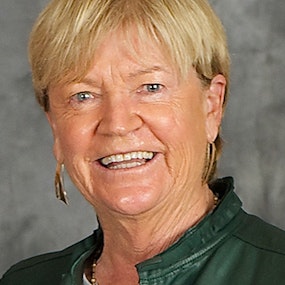
Blalock, Jane
Golf Professional
Jane Blalock is a former LPGA Tour champion who won 27 times and is perhaps best known for her record 299 consecutive tournaments played without missing a cut.
Today, Blalock is involved with two significant golf properties that have had a huge impact on advancing women in the game for the past two decades: the Women's PGA Clinics and Legends of the LPGA, Official Senior Tour of the LPGA.
Golf champion. Business guru. Activist trailblazer. Jane Blalock has racked up a lifetime of achievements that few others can claim.
Blalock joined the LPGA Tour in 1969 and remains one of its winningest players in history with 27 titles. A record-holder across all professional men’s and women’s golf tours, playing 299 consecutive tournaments without missing a cut, she retired from the tour in 1985 but not the sport, and has continued to have an indelible impact.
She founded JBC Golf, Inc. in 1990. This Boston-based golf and event marketing firm creates golf sponsorships and marketing opportunities for Fortune 500 companies and major corporations, consistently delivering goal-driven results. In 2001, Blalock spearheaded the Women’s Senior Golf Tour – now known as Legends of the LPGA, official senior tour of the LPGA – a coup for women of professional golf age 45 and over, creating opportunities for continued competitive golf in career afterlife.
Blalock also created and now heads up Women's PGA Clinics, a 30-year program that brings advanced instruction to the growing number of women who’ve developed a love of the sport for business and pl…
Read More
New to FORE the Good of the Game?
Here are some great episodes to start with. Or, check out episodes by topic.















